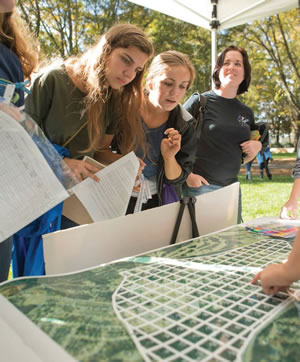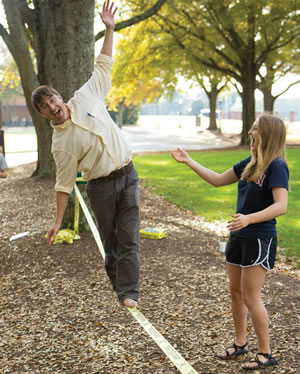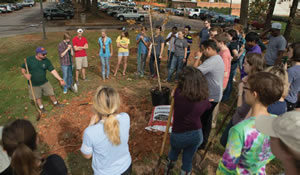Facilities (Campus Spaces)
Campus as Place
- By Yancey Fouché
- August 1st, 2014

PHOTOS COURTESY OF FURMAN UNIVERSITY
Furman University, a residential liberal arts university in Greenville, SC, is widely known for its beautiful campus, commitment to sustainability and opportunities for deep undergraduate student research. These three components came together in the recent designation of the campus as a Level I arboretum through The Morton Register of Arboreta. Furman earned the recognition for exemplifying tree conservation, species diversity, and educational resources and events focused on landscapes and trees.
Many of Furman’s 2,600 undergraduate students and the local community are drawn in by the beauty of its 745-acre campus. In recent months, BuzzFeed listed Furman as one of “10 Uniquely Stunning College Campuses From Around the World.” Other honors include being listed among the 50 prettiest U.S. college campuses by “The Best Colleges” website, the top 10 “Prettiest College Campuses in the World” by Delta Sky magazine, and “America’s Most Beautiful College Campuses” by Forbes magazine and Travel + Leisure.
In 1956, the university relocated from downtown Greenville to its current suburban location at the foot of the Blue Ridge Mountains. The campus boasts tidy Georgian architecture, well-groomed landscapes and lots of trees. A central image and the spine of campus is its shady, oak-lined mall. Planted trees of 55 labeled species — primarily natives — grace the built space, while intact Southern Appalachian Oak forests surround the campus proper, shading a network of off-road trails, walking paths and a major rail-trail connecting the cities of Greenville and Travelers Rest.
A charter signatory to the American Colleges and University Presidents’ Climate Commitment, Furman has been a leader in comprehensive sustainability master planning, commitment to carbon reduction and integration of sustainability into academic life across disciplines. Campus forest communities provide an important lab for academic study and inspiration and serve critical functions in support of goals around water quality of the iconic lake, biodiversity and quality of life.
Cross-Campus Collaboration

PHOTOS COURTESY OF FURMAN UNIVERSITY
At Furman, the home for the arboretum project is the David E. Shi Center for Sustainability, an academic unit whose mission is to promote the interdisciplinary study and practice of sustainability on campus and in the greater community. However, the project was only possible through broad and committed coalitions of stakeholders.
Efforts built on an ongoing initiative for campus tree identification spearheaded by biology professor and botanist A. Joseph Pollard. Dr. Pollard and other faculty worked with numerous students to help catalog species and maintain tree tags. Since 2008, a designated Center for Sustainability staff member and student Campus Landscape Fellow have worked together to organize an Arbor Day celebration and to secure Tree Campus USA status for the campus through The Arbor Day Foundation. In recent years, activities have included tree plantings, slacklining (a form of tightrope walking on a line strung between two trees), supervised tree climbs with a certified arborist, volunteer projects supporting campus grounds and of course, great apple cider. In conjunction with Arbor Day, classes in the Sociology, Economics, Earth and Environmental Sciences and Biology departments worked together to assess ecosystem services of campus trees. These data were used as a basis for reporting on tree cover for the university’s greenhouse gas inventory.
A campus Trees Committee, comprised of a select group of Grounds staff, Center for Sustainability representatives, one interested faculty member and a community member, has been a tremendous vehicle for integration of the campus landscape with educational efforts. The expertise and engagement of campus grounds staff have been key to providing information ranging from long-term landscape planning and management to best species for tree planting ceremonies to offering ideas and support for viable service projects. Responsibility for convening committee meetings lies with a Center for Sustainability student fellow — a tremendous opportunity for professional development.
The Designation Process
In 2013, much of the needed administrative structure, partnerships and even a campus trees master plan were in place. However, a generous gift from the estate of George G. Willis, Jr. enabled the university to dream big and feel confident in having the means to manage and share its unique landscape for years to come. As a focus for her work in academic year 2013-14, student fellow Kylie Stackis worked through The Morton Register and the Accreditation Program application process at arbnet.org, consulting the Trees Committee for feedback and visioning.
Future improvements laid out in Furman’s application include installing interpretive signage for distinct educational landscapes, organizing guided “tree walks” for the public and enhancing online resources.


PHOTOS COURTESY OF FURMAN UNIVERSITY
INTO THE WOODS. As part of campus-wide efforts, Furman University constantly seeks ways to infuse sustainability into its curriculum and operations. In establishing a campus arboretum, a Furman Trees Committee comprised of students, faculty, grounds staff and community partners developed an extensive arboretum management plan to monitor and maintain tree health and safety, as well as increase species diversity with a focus on local species. As a result of this commitment, Furman has received accreditation as a Level I arboretum through The Morton Register of Arboreta.
Lessons for Other Schools: An Arboretum Needs a Home
The George G. Willis Jr. Arboretum strives to be a model for other arboreta in the Southeast and across the nation. We hope that guests will come to walk our campus to explore the forests and tagged trees, and take advantage of additional outreach opportunities as they are developed.
A key recommendation is that universities designate a “home” to ensure the long-term success of such projects. At Furman, this home will be the Shi Center for Sustainability as a means to provide students educational and professional development opportunities related to environmental interpretation. Says Professor and Director of the Center for Sustainability Angela Halfacre, “Furman’s commitment to sustainability is evident in every decision the university makes, and this includes an emphasis on quality of life and taking the long view. The arboretum is a highly visible and beautiful way Furman contributes to our community and engaged learning.”
THE MORTON REGISTER OF ARBORETA
The Morton Register of Arboreta is a comprehensive list and database of arboreta and other public gardens that have a substantial focus on woody plants. The purpose of the Morton Register is to identify all of the organizations that collect and display trees, shrubs and other woody plants for the benefit of the public, science and conservation.
Any identified or named arboretum, or a public garden with a significant focus on woody plants, may be listed on the Morton Register of Arboreta. All known arboreta in the United States are listed, and others will be added to the register when identified. Early emphasis has been placed on named arboreta in the U.S., but arboreta from other countries will now be added, together with other tree-focused public gardens.
Accreditation is available for arboreta through the Morton Register of Arboreta. Arboreta are accredited at different levels depending on degrees of development, capacity and professionalism.
In addition to Furman University, other colleges and universities listed on the Morton Register of Arboreta include the Connecticut College Arboretum (New London, CT), the Elmhurst College Arboretum (Elmhurst, IL), the University of Maryland Arboretum and Botanical Garden (College Park, MD), the Scott Arboretum of Swarthmore College (Swarthmore, PA), the Doane College Osterhout Arboretum (Crete, NE) and the Stanford University Arboretum (Palo Alto, CA).
For more information, visit arbnet.org.
This article originally appeared in the August 2014 issue of College Planning & Management.